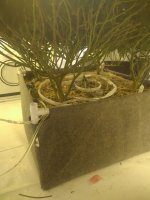legacy.cannabis.nz
Well-known member
Hi there,
Im quite late to this thread, but living soil is a subject I really love, and can offer a world of advice on.
Making your base mix does not have to be complicated. Your base sounds really rich to me, and with the additions of chicken manure and guano, your mix will definitely run hot, and require around 2 to 3 weeks of cooking to calm down.
A good base mix is organic compost 50 50 fungi/bacteria dominated and or worm castings , peat moss (great ph buffer), and pumice.
50% compost/worm castings
25% peatmoss
25% pumice
Living soils have gone very far in recent years, with goals of GMP grade medical.. living soil scientists have been raising the bar.
This being said, one thing they are steering clear of - is animal manures. They are great, but are at risk of many unwanted contaminants, so generally those high grade living soil grows use anything but. Worm castings being the closest to manure they will use.
The biggest key to "Living Soils" is to actually keep them alive/living! So beneficial microbes, fungis, bacterias, bugs, worms etc can thrive and in turn create a soil food web between them and the plants living within.
"Teaming with Microbes" by Jeff Lowenfels is a brilliant book describing this process.
Making your composts a 50 50 fungi and bacterially dominated compost is a another big key.. this is done by equal ratios of both green and brown waste.
Mulching both green and brown is also very important.. maintaining fungi and bacteria populations.
Forget anything you have learned about dry back... Living soil needs a maintained moisture content.. your plants will thrive in this believe it or not. A digi moisture meter is a key tool, and maintaining 80 to 120mbars is optimum.
Your soil should run itself from here, and keep your plants nice n healthy. Without anything else needed
Additional bonus organic components, dry amendments etc can be applied straight to the top of the soil - I recommend doing this with additional compost and re mulching, Or, as nutrient water drenches.
There are also many great organic amendments now available... Anything with fulvics, and humics is worth buying. Pure amino acids are totally worth using in soil drenches right up untill week 6 of flower. Kelp foliage sprays will make life easy, and greatly encourage sugar exchange between your plants and microbes meaning super healthy plants. Just stop using once flowers are formed.
K Humates, Langbenite, and coconut water are great flowering additives.
You can quite comfortably go water only too.
This soil is sustainable, ie - reusable for many years. I do recommend soil tests/prescriptions and cover crops in between crops
Any other questions regarding living soil, ask away any time

Im quite late to this thread, but living soil is a subject I really love, and can offer a world of advice on.
Making your base mix does not have to be complicated. Your base sounds really rich to me, and with the additions of chicken manure and guano, your mix will definitely run hot, and require around 2 to 3 weeks of cooking to calm down.
A good base mix is organic compost 50 50 fungi/bacteria dominated and or worm castings , peat moss (great ph buffer), and pumice.
50% compost/worm castings
25% peatmoss
25% pumice
Living soils have gone very far in recent years, with goals of GMP grade medical.. living soil scientists have been raising the bar.
This being said, one thing they are steering clear of - is animal manures. They are great, but are at risk of many unwanted contaminants, so generally those high grade living soil grows use anything but. Worm castings being the closest to manure they will use.
The biggest key to "Living Soils" is to actually keep them alive/living! So beneficial microbes, fungis, bacterias, bugs, worms etc can thrive and in turn create a soil food web between them and the plants living within.
"Teaming with Microbes" by Jeff Lowenfels is a brilliant book describing this process.
Making your composts a 50 50 fungi and bacterially dominated compost is a another big key.. this is done by equal ratios of both green and brown waste.
Mulching both green and brown is also very important.. maintaining fungi and bacteria populations.
Forget anything you have learned about dry back... Living soil needs a maintained moisture content.. your plants will thrive in this believe it or not. A digi moisture meter is a key tool, and maintaining 80 to 120mbars is optimum.
Your soil should run itself from here, and keep your plants nice n healthy. Without anything else needed
Additional bonus organic components, dry amendments etc can be applied straight to the top of the soil - I recommend doing this with additional compost and re mulching, Or, as nutrient water drenches.
There are also many great organic amendments now available... Anything with fulvics, and humics is worth buying. Pure amino acids are totally worth using in soil drenches right up untill week 6 of flower. Kelp foliage sprays will make life easy, and greatly encourage sugar exchange between your plants and microbes meaning super healthy plants. Just stop using once flowers are formed.
K Humates, Langbenite, and coconut water are great flowering additives.
You can quite comfortably go water only too.
This soil is sustainable, ie - reusable for many years. I do recommend soil tests/prescriptions and cover crops in between crops
Any other questions regarding living soil, ask away any time







